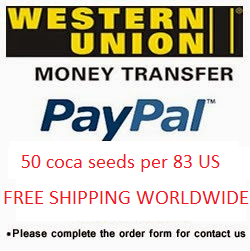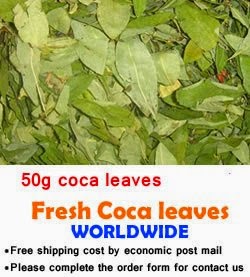THE OLDEST AND MOST POPULAR WAY TO CONSUME ALCALOID COCAINE IS VIA ORAL INTAKE, BY ABSORBING IT FROM WHOLE LEAVES LIKE THE TRADITIONAL CHACCHADORES OR LEAVES CHEWERS FROM THE ANDES AND THE AMAZON, OR BY DRINKING COCA LEAVES INFUSIONS, OR BY GRINDING LEAVES TO MAKE FLOUR LIKE SOME BRAZILIAN AND COLOMBIAN COMMUNITIES DO, NEAR BOLIVIA AND PERU.
FRUITS AND STEMS ARE NOT USED for the chewing AND
INFUSIONS, JUST THE LEAVES. BEFORE
CHEWING, the LEAVES ARE MIXED with aN alcalin SUbSTANCe MADE FROM ROOTS AND
BURNT STEMS, OR QUICKLIME, CALLED LLIPTA OR TROCA. THEY DO THIS TO EXTRACT COCAINE
FROM THE LEAVES (CARROLL, 1977; CARTER & MAMANI, 1978; MACHICAO, 1986). during
the 1990S coca was mostly used (90.1%) In BOLIVIA, <0.1% (COLOMBIA), 5%
(ECUADOR), AND 5.3-30.5% (PERU) (NEGRETE,
1992; MONTOYA & CHILCOAT, 1996). NOwaDAYS
(2006), COLOMBIA HAS BECOME THE LARGEST MANUFACTURER OF COCA PLANTS (COCA
LEAVES; ALMOST ALL OF THE PRODUCE IS USED FOR DRUG TRAFfICKING.
FRUITS AND STEMS ARE NOT USED for the chewing AND
INFUSIONS, JUST THE LEAVES. BEFORE
CHEWING, the LEAVES ARE MIXED with aN alcalin SUbSTANCe MADE FROM ROOTS AND
BURNT STEMS, OR QUICKLIME, CALLED LLIPTA OR TROCA. THEY DO THIS TO EXTRACT COCAINE
FROM THE LEAVES (CARROLL, 1977; CARTER & MAMANI, 1978; MACHICAO, 1986). during
the 1990S coca was mostly used (90.1%) In BOLIVIA, <0.1% (COLOMBIA), 5%
(ECUADOR), AND 5.3-30.5% (PERU) (NEGRETE,
1992; MONTOYA & CHILCOAT, 1996). NOwaDAYS
(2006), COLOMBIA HAS BECOME THE LARGEST MANUFACTURER OF COCA PLANTS (COCA
LEAVES; ALMOST ALL OF THE PRODUCE IS USED FOR DRUG TRAFfICKING.
The chemical
analysis of coca leaves shows they may contain between 0.25% and 2.25% alkaloids,
of which 14 have been identified. Among the nutritional substances (Collazos
et al, 1964; Duke et al, 1975; Ramos-Aliaga, 2005, one of the most
important ones is cocaine (Martín
et al, 1970). According
to a later publication, (Turner et al, 1981) coca leaves
contain 19 alkaloids, including nicotine. The first
chemical analysis of the commercial presentation called mate de coca (Bolivia and Peru), which contains
whole ground coca leaves, showed an average of 234.5 mg cocaine in 100 grams of
leaves (National Health
Institute, Lima, 1982). The
first report about decocainization of mate
de coca (requested by
Hagelin and Co. Inc.) dates from 1988 and states no cocaine nor ecgonin were detected. (Industrial Testing Laboratories,
New York, 4/21/1988).
Chemical
findings are subject to the form of cocaine extraction, which can be natural (alkaloid)
or through different preparations that have been manufactured since the
nineteenth century, many of which are no longer in production, such as citrate and
bromate-cocaine. Hydrochloride is the only official pharmaceutical formula with
less than 10% cocaine. (Fleming
et al, 1990). Later,
addictive products for drug trafficking appeared on the market such as cocaine
paste, freebase and crack, which contains a high percentage of toxic substances
from the chemical process in its preparation. (Morales-Vaca,1984; Arif,
1997).






0 comments:
Post a Comment
Many thanks by contact Us, we will respond promptly, Regards